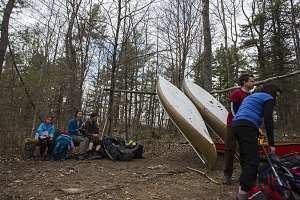We awoke to cool and cloudy conditions. Still, much better than last year, when our first night and morning had been rainy. The wind had dropped off, making the morning campfire easier to manage.
As is typical with canoe trips, we had a breakfast filled with heavy, water-filled items - the sort of thing you would not dare to carry on a foot-powered backpack: fruit, eggs, muffins, bacon - that sort of thing. Enjoyable when you can do it, though.
Breakfast, Cedar Lake campsite
Arn's plan for this year's trip was a big triangular loop, starting and ending at the dock at Brent. Two major river systems - the Petawawa and the Nipissing - drained into Cedar Lake, and these two rivers would form two of the sides of our trip's "triangle". Today we would head up the Petawawa river to Catfish Lake, which apparently contained many fine campsites. We'd spend two leisurely days there, enjoying the island-studded lake and environs, before returning via the Nipissing river system back to Cedar Lake and the dock at Brent.
After finishing breakfast and packing up by a leisurely (by my standards, anyway) 9am, we set off from our Cedar Lake campsite. It was only a very short - perhaps ten minute - paddle from the campsite to the mouth of the Petawawa river into Cedar Lake. As we approached, we could clearly see the wide and rapid-filled slope of the river emptying into the lake. No way we'd be canoeing up that!

courtesy JInnes
A medium-length 700-metre bypass of the rapids on the Petawawa kicked of the first of our portages. Remembering the pain and numbness in my arms and shoulders from last year's trip, I had purchased a yoke pad this year. It was immediately apparent that this helped immensely; although not perfect, portaging the canoe was much less uncomfortable.
Above the rapids, we put into the Petawawa River - now a placid and wide slow flow of water. The current was mild enough here that we were able to make upstream progress fairly easily.
An abundance of foamy water indicated some upstream maelstrom, and soon we could see and hear a substantial waterfall ahead, along with a tell-tale yellow sign on a nearby tree: our second portage.
A quick 300-metre portage brought us to another calm and wide stretch of the Petawawa River, which we dispatched with relative ease.
We then arrived at the big challenge for the day: a very long (by canoe-tripping standards) portage: a 2,345-metre (nearly 2.5 kilometre) walk through the woods with a canoe on one's head. Even with the yoke cushion, I wasn't looking forward to this one.

Halfway through a long one
The long portage was unpleasant. It had a fair bit of elevation gain, and I was dripping in sweat by the time I arrived at the halfway point, where the park had thankfully arranged a nice rest spot, complete with a canoe-resting cross-log and a few benches.
The mid-point rest was quite rejuvinating, and the remainder of the portage seemed easier (probably also to do with the fact that the terrain was no longer uphill past this point). Still, I was glad to see the sight of water ahead, for it meant I would soon be putting down my delicately-balanced burden.
The Official Eveline Portage Shot
A very quick paddle across the Petawawa River brought us to another portage, this one thankfully a very short 170 metres. We were then on Narrowbag Lake - the penultimate body of water before arriving at our destination for the day: Catfish Lake.
A final trivial 80-metre portage around one set of rapids brought us to the start of Catfish Lake. The plan: paddle along past the many little islands that dotted the lake's waters, looking for an attractive-looking (and free) campsite.
First, though, we headed for a special little islet - one that contained a piece of the Algonquin region's forestry history. On this little island, we visited the rusted-out remnants of what is known as an alligator boat. This is (or rather, was) a steam-powered paddleboat that was used to haul log booms through Algonquin's waterways, back in the mid and late 19th century. Alligator boats were amphibious; they had the ability to self-portage between lakes via a winch system. Hmm... too bad we couldn't use such a system for portaging today....
Arriving alligator island
After completing our inspection of the historic relic of the alligator, we continued on. The day had been mostly cloudy, and we'd even had a few spits of rain at times. But now the sun was coming out in earnest, transforming the grey day. Scenic forest-topped rock islands glided past, with fir and spruce trees frequently bending out over the water in a very picturesque way.